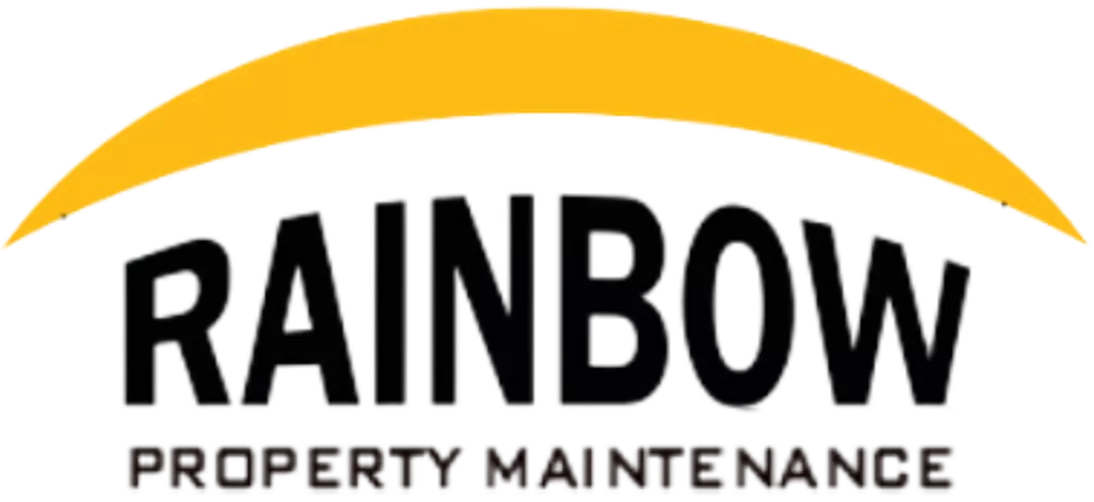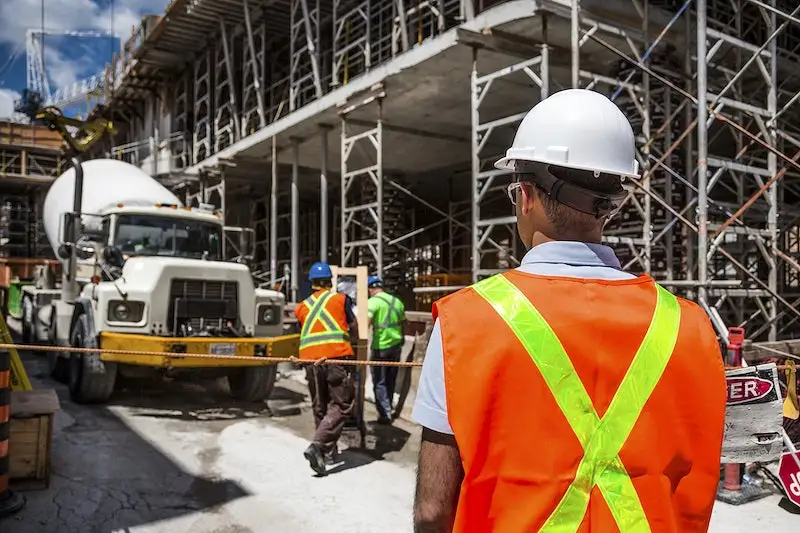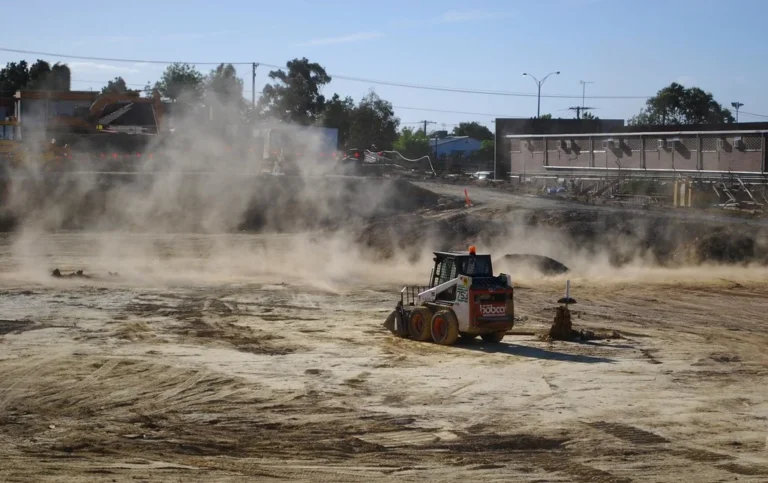Best Practices for Sustainable Dust Management on Construction Sites in 2024
Best Practices for Sustainable Dust Management on Construction Sites in 2024
As the construction industry continues to grow, the imperative for sustainable practices becomes ever more pressing, especially in controlling worksite dust. Adopting best practices for sustainable dust management can not only enhance environmental stewardship but also ensure regulatory compliance and promote the health and safety of workers and the surrounding community.
Key Takeaways:
- Sustainability meets compliance: Eco-friendly dust control is essential for meeting industry regulations and standards.
- Worker health is paramount: Effective dust management directly correlates with the well-being of site workers.
- Community relations: Good dust control practices minimize the impact on nearby communities and enhance the construction company’s image.
- Long-term cost savings: Investing in sustainable practices now can lead to significant future cost reductions.
- Technological advancements: Utilizing the latest dust suppression technologies offers efficient and environmentally-conscious solutions.
Understanding the Impact of Construction Dust
The Environmental and Health Risks of Dust Emissions
Uncontrolled dust from construction sites poses a real risk to both the environment and human health. Dust particles, fine and coarse, can travel far and wide, affecting air quality considerably. Construction dust, often containing silica, can lead to severe respiratory issues when inhaled by workers and residents in nearby areas. Moreover, this dust can settle on waterways and soil, disrupting habitats and potentially contaminating drinking water sources. In the cityscape, the particulate matter from construction sites contributes to haze, which can have broader climate implications. It’s a concern that extends well beyond the borders of the worksite, influencing urban livability and the health of entire neighborhoods.
Potential Hazards of Construction Dust Types
Construction sites churn out various types of dust, and each carries its own hazards. Silica dust, produced when working with concrete, bricks, or tiles, is infamous for causing silicosis, a chronic lung disease. Wood dust can cause dermatitis and respiratory conditions, while asbestos, though less common nowadays, remains a deadly health threat when disturbed during renovations and demolitions. Addressing these risks requires identifying the types of dust involved and implementing strategies to manage or mitigate them effectively. Identifying the potential hazards is the first step in protecting workers and the environment from the adverse effects of dust emissions. We at Rainbow Property Maintenance understand the stakes involved in construction dust management. Explore our Construction Cleaning Services for a safer worksite.
Regulatory Framework for Dust Control
Dust Regulations: A National Overview
In the United States, the regulation of construction dust falls under the purview of multiple agencies, including OSHA and the EPA. Federal guidelines mandate the minimization of hazardous airborne particulate matter to protect workers and the environment. Firms must follow specific dust suppression strategies, such as wetting down work areas or using vacuums with HEPA filters to capture fine particles. Compliance is more than adhering to rules; it is a stride toward protecting workforce health and safeguarding our communities.
Compliance Through Sustainable Practices
Embracing sustainable practices isn’t just green rhetoric; it’s a concrete way to ensure adherence to dust control regulations. Strategies such as reusing water for dust suppression or investing in electric-powered machinery cut down on particulate pollution and carbon footprint simultaneously. Adopting these measures isn’t only about following laws; it demonstrates a commitment to the well-being of our society and the planet. Eco-conscious actions resonate well with clients and regulatory bodies alike, reinforcing a company’s stature as a responsible industry player. For businesses at the forefront of sustainable development, understanding and applying these regulations is synonymous with leadership in the push for a cleaner construction industry. It’s a commitment we at Rainbow Property Maintenance take seriously, and our services reflect that dedication. Discover our expert Industrial Cleaning Services in Chicago. Through diligence and innovation, we support our clients to meet and exceed regulatory standards.
Innovative Dust Suppression Methods
Emerging Technologies in Dust Control
The landscape of dust suppression is undergoing a transformation, thanks to emerging technologies. Today, companies can choose from a plethora of cutting-edge options, such as electrostatic dust suppression systems that capture airborne particles using an electrical charge, or fogging cannons that emit fine mists to bind with dust and prevent dispersion. These innovations are not just effective; they also align with green initiatives due to their resource efficiency and reduced ecological footprint.
Sustainable Options Versus Traditional Approaches
When compared to conventional methods like water truck sprays, these novel sustainable options offer marked improvements. Traditional approaches often require ample water and labor, leading to increased costs and environmental strain. In contrast, new technologies enable pinpoint accuracy in targeting dust, minimize water usage, and can often be automated, which translates to operational cost savings and a diminished environmental impact. Companies now have the opportunity to leap forward in efficiency and sustainability by integrating these advanced dust suppression methods. No longer a matter of mere compliance, this technology is a statement of a company’s forward-thinking ethos and ecological consciousness. Firms that adopt these methods are not just meeting standards; they’re setting them. At Rainbow Property Maintenance, we recognize the importance of staying ahead of the curve with innovative methods. Explore our Construction Cleaning Services in Chicago and see how we’re incorporating these breakthroughs into our services to benefit our clients and the environment.
Training and Awareness for Sustainable Dust Management
Essential Training for Effective Dust Control
For sustainable dust management on construction sites, the role of employee education cannot be overstated. Workers need to understand not just what measures to take, but also why they are crucial—for their health, for regulatory compliance, and for the environment. By providing training on the use of dust suppression systems and personal protective equipment, we can shift behavior and make safe practices routine. Educational programs should encompass the risks associated with construction dust, the importance of reporting hazards, and the correct use of dust control technologies. Equally important is instilling a sense of personal responsibility so that every team member feels accountable for maintaining a dust-free worksite.
Cultivating a Sustainability Culture
Beyond individual training sessions, creating a culture of sustainability requires ongoing conversations about eco-friendly practices and their positive impacts. It’s about reinforcing good habits and rewarding adherence to procedures that prioritize dust control. A culture of sustainability thrives when workers understand that their actions contribute to larger environmental goals and to the company’s reputation as a responsible contractor. Engaging crews in sustainability goals also means staying abreast of innovations in dust suppression and inviting feedback on the effectiveness of current practices. Committing to improvement sends a powerful message that the company values both the environment and the well-being of its employees. At Rainbow Property Maintenance, we’re all about promoting a sustainability culture in every project. Explore our Construction Cleaning Services in Chicago to witness our commitment to not just cleanliness, but also education and environmental stewardship. Through our training programs, we empower workers to take part in our vision for a sustainable future.
Assessing and Monitoring Dust Levels on-site
Effective Strategies for Regular Dust Level Assessment
In the sphere of construction, regular assessment of dust levels is paramount to maintain a safe and compliant worksite. Effective strategies entail a blend of visual inspections and the use of particulate monitors that can detect and quantify the concentration of dust in the air. This regular assessment allows for immediate corrective actions, ensuring that projects adhere to safety and environmental standards. One approach involves setting up fixed monitoring stations at key locations to continuously gather data on airborne particles. Additionally, portable devices can be utilized by workers to conduct spot checks, providing a comprehensive overview of dust levels across the site. These measures allow for a swift response to potential overexposure and help maintain air quality.
Utilizing Monitoring Technology for Real-Time Dust Control
Advancements in dust monitoring technology now enable real-time control over dust emissions. Wireless sensors and cloud-based platforms permit site managers to track dust levels remotely and adjust suppression measures instantaneously. This proactive stance on dust management ensures that worker exposure to harmful particulate matter is minimized. Automation in monitoring also reduces the need for manual data collection, streamlining the process and freeing up resources for other critical safety activities. Utilizing these innovative solutions positions a business as a committed guardian of occupational health, leveraging technology to create a safer construction environment. Keeping a watchful eye on dust levels is a task we at Rainbow Property Maintenance take seriously, integrating state-of-the-art monitoring into our workflow. Discover our expert Industrial Cleaning Services for dust control, utilizing the latest innovations for impeccable dust management. Through continual monitoring and real-time response capabilities, we help our clients achieve the highest standards of cleanliness and safety.
Cost-Benefit Analysis of Dust Management Investments
Financial Advantages of Dust Control Measures
Investing in dust control measures on construction sites is not just an operational expense; it’s a strategic financial decision with long-term benefits. Companies that proactively implement dust reduction strategies can experience a decrease in direct costs associated with equipment wear and tear, site cleanup, and material loss. Furthermore, maintaining low dust levels reduces the risk of costly health claims and improves the efficiency of the workforce, leading to a healthier bottom line.
Weighing Sustainable Investments Against Potential Costs
The value of investing in sustainable dust management becomes even clearer when weighing against the potential financial burdens of non-compliance. Fines for violating environmental or workplace regulations can be steep, and the cost of remediating environmental damage or managing health-related lawsuits far exceeds the initial outlay for dust control systems. Sustainable practices, such as using advanced filters or green dust suppressants, can also serve as a preventative investment, enhancing a company’s reputation and enabling it to qualify for green certifications. These certifications can open doors to new business opportunities and qualify the company for certain tax incentives. Understanding the full spectrum of financial benefits that derives from sustainable dust management is pivotal for businesses striving for longevity and industry leadership. Explore our Construction Cleaning Services for a safer worksite, and consider how such foresight in dust control can secure a more profitable and responsible future. At Rainbow Property Maintenance, we stand ready to help you analyze and implement the most beneficial dust management investments for your company’s enduring success.
Enhancing Community and Client Relations
Fostering Goodwill Through Dust Management
The effects of construction dust extend far beyond the confines of a jobsite, impacting the air quality and comfort of adjacent communities. Rigorous dust management not only shields the well-being of our neighbors but also fortifies goodwill and trust with local residents. By employing best practices in dust control, we demonstrate respect for the community’s health and their living environment, fostering a positive perception of our construction projects. Taking a proactive approach to dust control can also serve as a public relations asset, showcasing our company as a conscientious and responsible entity. Through transparent communication about the measures we are implementing to protect the community, we engender trust and reinforce our commitment to corporate responsibility.
Transparency as a Catalyst for Enhanced Reputation
Sustainable efforts in dust management do more than just comply with regulations; they underline our investment in community welfare and environmental stewardship. When we discuss openly our sustainable practices and the technologies we employ, this transparency becomes instrumental in enhancing our company’s reputation. Client trust also deepens when they recognize our unwavering dedication to safety and sustainability, distinguishing us from competitors and bolstering our status as a trusted partner. By embedding sustainability into our operational ethos, we not only act in service of the environment but also validate our pledge to the betterment of the industry and the communities we serve. At Rainbow Property Maintenance, our commitment to sustainability shapes our every action. Explore our Construction Cleaning Services for a safer worksite, and see firsthand how we leverage dust management to cultivate enduring relationships with both our clients and the communities we touch. Together, we set a standard for excellence and community engagement, projecting a notable reputation that’s built on trust, transparency, and our unwavering commitment to the environment.
Future Trends in Dust Management
The Evolution of Dust Suppression Practices
The future of dust management in construction is marked by the burgeoning use of sophisticated technologies that promise even greater control and effectiveness. Looking forward, we envision practices that not only mitigate dust after it’s been generated but preemptively address the creation of dust through smarter, more efficient building techniques and materials. Industry experts predict an uptick in the integration of automation and IoT devices in dust monitoring and suppression efforts. This will likely include the use of drones for site surveying and the remote application of suppressants, as well as AI-driven analytics to predict high-risk scenarios and automate responses.
Regulatory Changes Shaping Construction Protocols
Regulatory landscapes are also expected to evolve with advancements in environmental health research. There may be more stringent standards imposed on permissible dust levels, coupled with a push for transparency and real-time reporting. As a result, construction firms will need to stay agile, adapting to new regulations with innovation and prompt compliance. This ongoing change will necessitate a keen investment in research and development within the sector. Firms poised to invest in these future trends will not only gain a competitive advantage but will also contribute to the field’s overall progress towards a sustainable future. We at Rainbow Property Maintenance are prepared to embrace and drive these advancements. Explore our Construction Cleaning Services for a safer worksite, and partner with a team that is committed to leading the charge in cutting-edge dust management solutions. We’re more than ready for the future of construction site cleanliness and safety, where our dedication to innovation ensures that our projects—and our clients—stay ahead of the curve.
Conclusions
Sustainable dust management is not a passing trend; it’s a fundamental component of modern construction – quintessential for the health of both the workforce and the community. The implementation of best practices in dust control is an exhibition of our dedication to environmental stewardship and a testament to our foresight in regulatory compliance.As we look to the future, we recognize that the construction landscape in 2024 will be firmly rooted in the advancements made today. The investments we make now in dust suppression technologies and worker training are crucial steps toward long-term cost savings and enhanced community relations.The integration of innovative methods for dust assessment and monitoring will ensure real-time control and operational excellence, while rigorous cost-benefit analyses of such investments will solidify the financial viability of these sustainable endeavors.In maintaining transparent and proactive communication with both the community and our clients, we fortify trust and client loyalty, bolstering our reputation as a conscientious industry leader.We invite you to partner with us to preserve both the environment and our industry’s integrity. Let us act now, for the safety of our workers and the betterment of our communities. Explore our Construction Cleaning Services for a safer worksite and discover our expert Industrial Cleaning Services for dust control. Together, we can usher in an era of operational success marked by positive environmental contributions – a legacy that begins with the conscious choices we make today.
Frequently Asked Questions (FAQ):
What are sustainable methods for dust management on construction sites?
Sustainable methods include the use of water sprays, dust suppressants, protective barriers, and advanced filtration systems designed to minimize environmental impact.
How can dust management impact a construction company’s reputation?
Efficient dust management can enhance a company’s image by demonstrating concern for environmental sustainability and community well-being.
Are there financial incentives for adopting sustainable dust management practices?
Yes, in addition to avoiding fines, companies might benefit from tax incentives or grants for implementing green initiatives.
Can technological advancements help in dust management?
Definitely. Technological advancements provide efficient and precise methods for monitoring and controlling dust on construction sites.








